

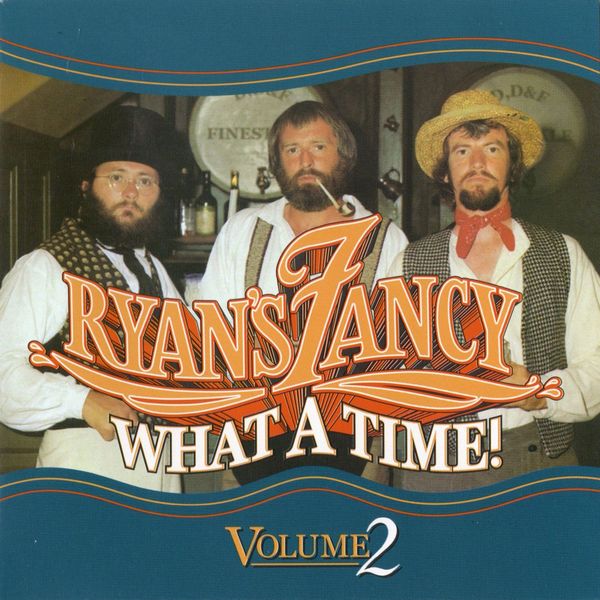 |
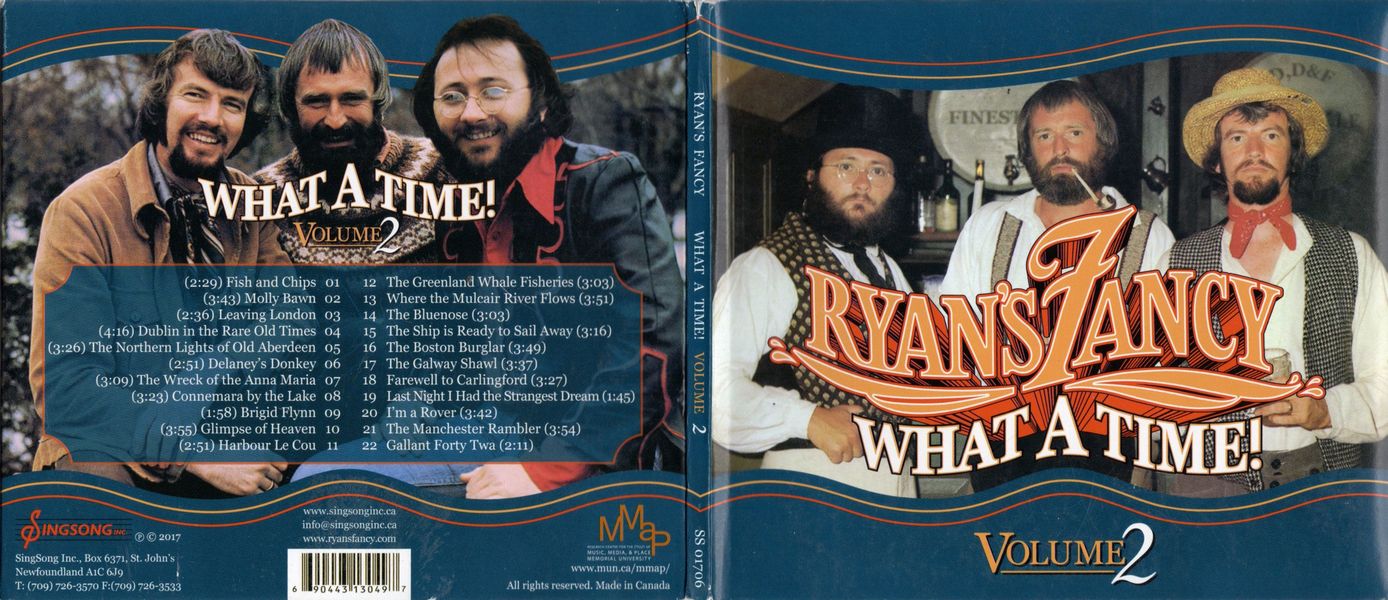
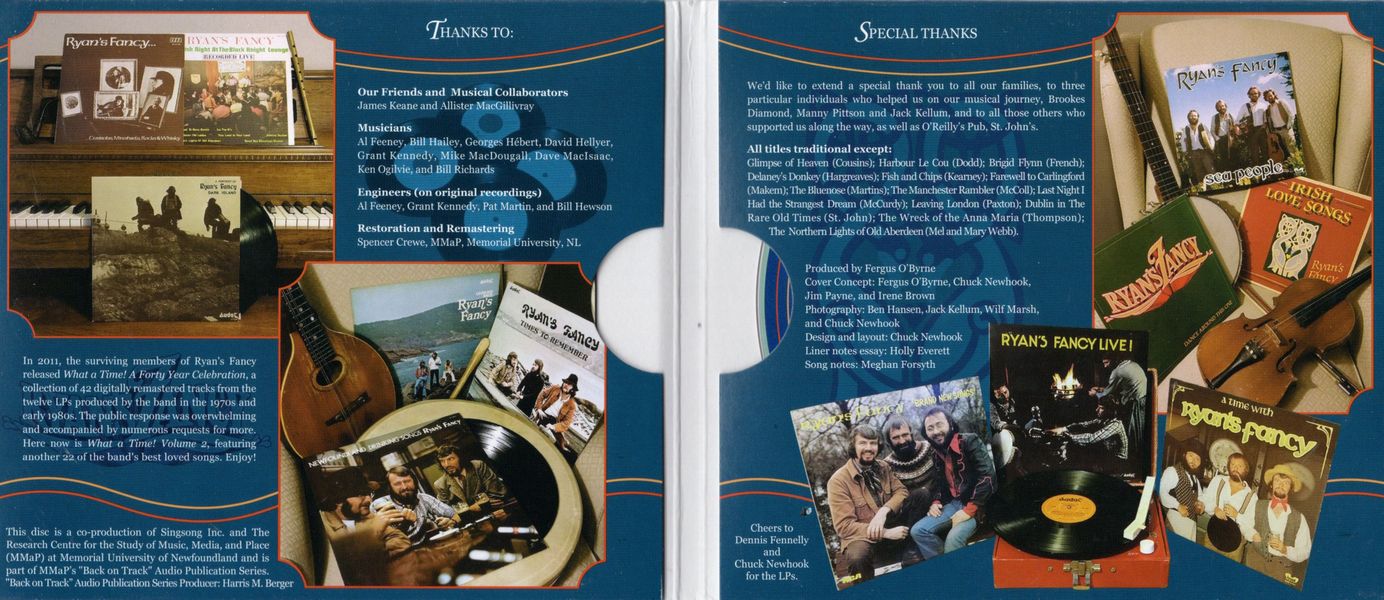 |
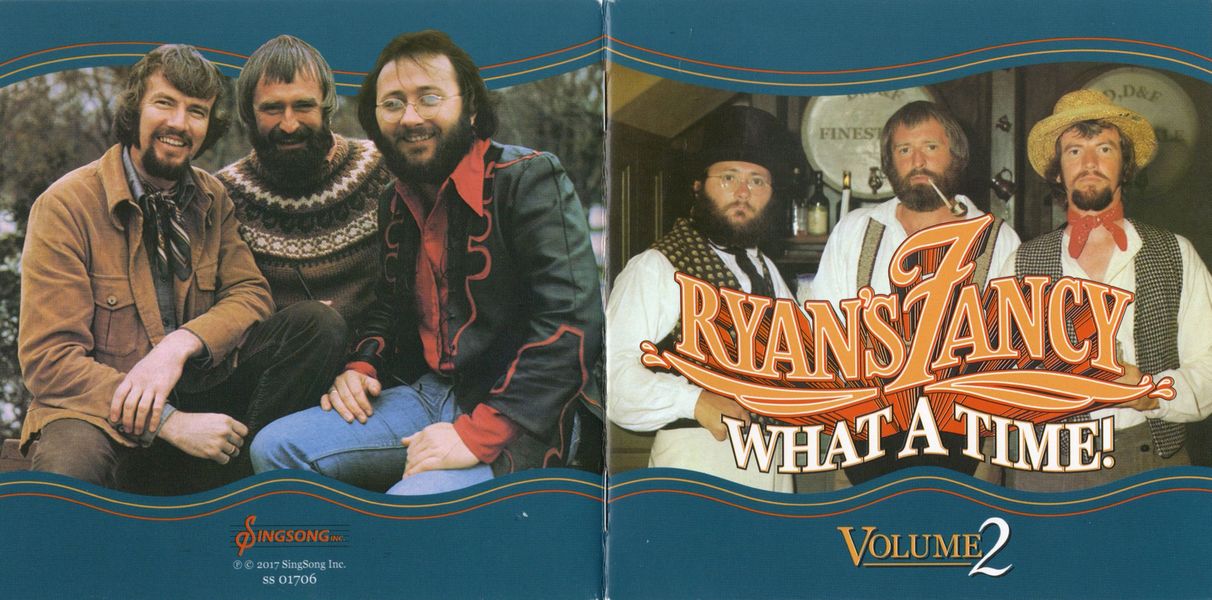
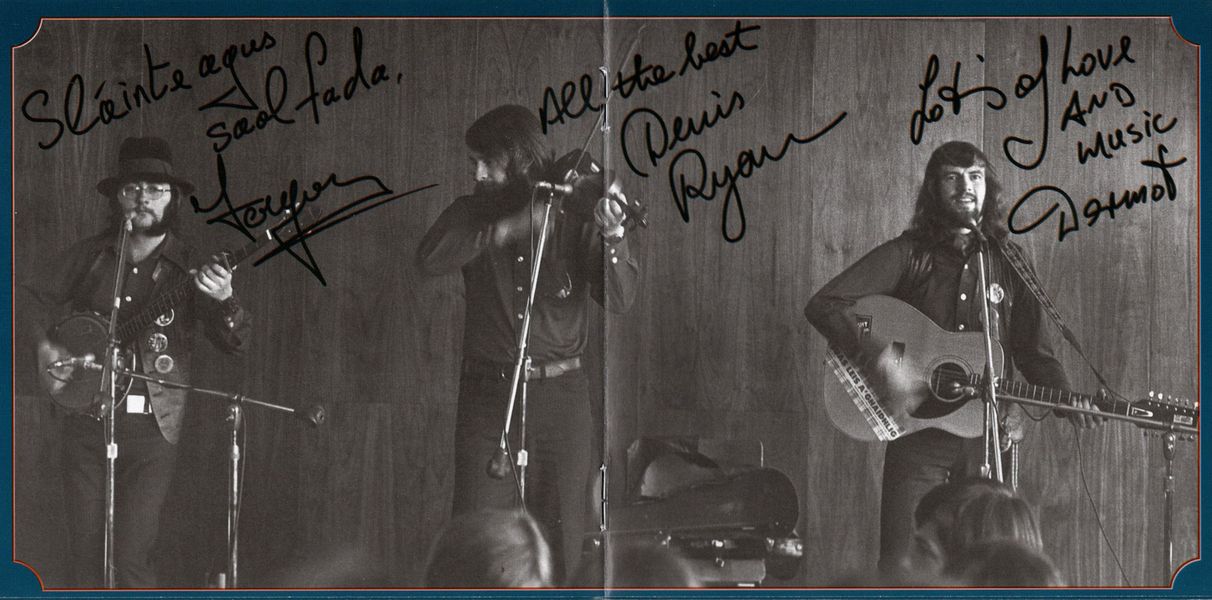
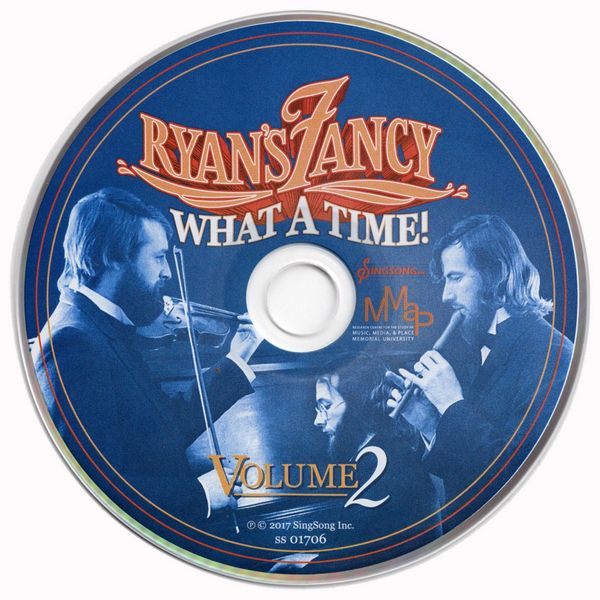 |
| more images |
Special thanks: We'd like to extend a special thank you to all our families, to three particular individuals who helped us on our musical journey, Brookes Diamond, Manny Pittson and Jack Kellum, and to all those others who supported us along the way, as well as O'Reilly's Pub, St. John's.
In 2011, the surviving members of Ryan's Fancy released What a Time! A Forty Year Celebration, a collection of 42 digitally remastered tracks from the twelve LPs produced by the band in the 1970s and early 1980s. The public response was overwhelming and accompanied by numerous requests for more. Here now is What a Time! Volume 2, featuring another 22 of the band's best loved songs. Enjoy!
Essay
"They're Ours and They're Loved Wherever They Go": The Cultural Impact of Ryan's Fancy
by Holly Everett
In 1970, the province of Newfoundland had been part of Canada for a scant twenty years. Still searching for their place in the confederation, Newfoundlanders of European descent began to turn their creative energies to a reinvigoration of local culture and a re-examination of their roots in England, Ireland, France, and Scotland. Coinciding with the first years of the Department of Folklore, as well as the emergence of interdisciplinary Newfoundland Studies at Memorial University of Newfoundland, people became interested in documenting and learning the songs and tunes they and their parents had grown up hearing. Some of these individuals would go on to perform the music they had collected and learned in folk rock bands such as Figgy Duff, Red Island, and the Wonderful Grand Band. Newfoundlanders were not the only ones interested in the province's traditional music, though.
In 1971, three musicians originally from Ireland moved to the provincial capital of St. John's. Fergus O'Byrne, Dermot O'Reilly, and Denis Ryan formed Ryan's Fancy, a group that Hans Rollmann, writing for the Independent in 2011, described as a "cultural phenomenon." Fergus, Dermot, and Denis met in Toronto in the late 1960s while performing with various local Irish acts, including the Sons of Erin with Gary Kavanagh and Ralph O'Brien, and eventually became founding members of the Celtic-folk group Sullivan's Gypsies.
As ethnomusicologist Evelyn Osborne has chronicled, the Sons of Erin's first gigs were at the Windsor House, an Irish pub in Toronto. Payment consisted of five draft beers. Although Fergus reports "We weren't players; we were singers and flailing away at guitars" (Osborne 2013, 248), their spirited performances soon drew a regular audience. With Sullivan's Gypsies, they toured Newfoundland in 1969 and 1970 with shows in St. John's, Gander, and Ferryland. It was during the St. John's stop on these trips that Fergus, Dermot, and Denis first performed at the legendary Strand Lounge in that city's Avalon Mall. The band was not surprised to find that their repertoire resonated with local audiences, given the long history of settlement by English, Irish, and Scottish immigrants, among others. The band was amazed, however, that the audiences sang along, word-for-word, to many of their songs, because locals knew them as Newfoundland songs, including such favourites as "Molly Bawn" and "The Rocky Road to Dublin." The island's rich repertoire, drawn from a variety of sources over centuries, included the music played by fishermen from Ireland and England's West Country, French and Gaelic songs sung along the southern and southwest coasts, music from locally produced songbooks, songs from country music radio stations dialed in from the States, and music from commercial recordings purchased in department stores or ordered through the mail.
The enthusiastic crowds that sang along with the band at their Strand Lounge shows helped convince Fergus, Dermot, and Denis to relocate to the province. They planned to enroll at Memorial University and continue gigging in town. But after a year or so of coursework, their growing popularity would take them away from their studies for a while. Between 1971 and 1982, they recorded 12 albums — 3 of those released in 1971 alone. Ryan's Fancy was also featured in not one, but two television shows: CBC's Ryan's Fancy (1972, 1978, 1981), the province's first national prime-time production; and CHCH television's Tommy Makem and Ryan's Fancy (1974-1976), filmed live at the Irish Canadian Club of Hamilton, Ontario and syndicated across Canada and in several countries around the world including Ireland. The success of these series led to a number of CBC television specials in the late seventies and early eighties, in addition to a made-for-television movie, Pirate's Gold (1980).
Significantly, the CBC show Ryan's Fancy took the band around the island, filming segments in outport communities. Looking ahead, the band would set up gigs around the filming schedule in local community halls, school gymnasiums, and bars in the area. One way or another, on camera and off, Fergus, Denis and Dermot were making music. Individuals including Rufus Guinchard, Minnie White, Emile Benoit, and Pius Power, who otherwise may never have been known outside of their small communities performed on the show, in many cases introducing tunes and songs that were new to the rest of the province. "The boys," as they were locally known, achieved a rare cultural standing, combining celebrity' and community-mindedness, through these appearances (Russell 1978). By this time known internationally, Ryan's Fancy continued to put the spotlight on the traditional music played and sung in homes across the province, highlighting the inclusive, comfortable musicality so integral to Newfoundland life. In the province's outports and small towns, Fergus, Dermot, and Denis heard echoes of Ireland that were handily matched by locally composed and tempered music and verse.
Not surprisingly, Ryan's Fancy is frequently cited as a profound influence on other Atlantic Canadian traditional musicians and bands that emerged in later years — the Barra MacNeils, Great Big Sea. the Irish Descendants, the Ennis Sisters, the Punters, and Natalie MacMaster, to name a few. Although Denis Ryan went into the investment business after the band broke up, he has released three solo CDs, Mist Covered Mountains (1991), Denis Ryan & Friends: Here and There (1998), and Let Me Fish Off Cape St. Mary's (2005), and continues to make guest appearances at prestigious charity events, both here in Canada and in Ireland. Following the disbanding of Ryan's Fancy, Dermot founded Piperstock Productions. Along with industrial and public service videos, Dermot produced two music documentaries: Rigs, Jigs, and Songs from the Heart about the island of Newfoundland, and Cain's Legacy: a Journey through Labrador. He continued to develop ideas for TV productions and remained a local favourite, performing in clubs, festivals, and in concert until his death in 2007. His influence lives on in the Dermot O'Reilly Legacy Award for the promotion of traditional music and dance at Memorial University.
Fergus O'Byrne maintains an active performing career, touring nationally and internationally as a solo artist and with his long-time musical partner, Jim Payne. He also performs with his son, Fergus Brown-O'Byrne. Fergus has been recognized with many awards and continues to be in demand as a recording artist. Through his work in public schools and the Newfoundland and Labrador Folk Arts Society's initiative, Young Folk at the Hall, Fergus has been an inspiration and mentor to countless young musicians.
The members of Ryan's Fancy made their mark in many cultural contexts in the course of their careers, from their early lives in Ireland, through their individual journeys to Canada, to their move to Newfoundland as a trio, and beyond. They were Irish musicians that many Newfoundlanders saw as committed to both the roots of the province's musical traditions and their evolution in the context of uneasy Confederation. Enthusiastically embraced by locals, the band members were passionate proponents of folk revival in general, and the Newfoundland folk revival in particular, as the province struggled to find its footing within a country that at times seemed to scorn it. Two decades into a new, contested national identity, Newfoundlanders yearned for the surety of tradition and at the same time struggled with it in reaching toward the mainland mainstream. Both on stage and off, Ryan's Fancy showcased local music traditions in a way that resonated with both insiders and outsiders in their deft embodiment of the Newfoundland musical ethos that beseeches everyone to join in. Come all ye!
Song Notes by Meghan Forsyth
As a fan of Ryan's Fancy for many years, I have always been interested in how certain songs ended up in their repertoire. The songs on this CD are a selection from the band's LPs released between 1971 and 1983. Fergus and Denis were kind enough to share their memories of the songs and the people and places that inspired them.
Fish and Chips (Down by the Liffeyside) — A song hearkening back to early 19th-century Dublin. Dermot's and Fergus's hometown. Fish and chips (a "one and one") was a great takeout snack eaten as one strolled around the streets of Dublin. The lyrics by Dubliner Peadar Kearney (1883-1942) offer a light-hearted view of Dublin-style courtship for the working class. The melody is taken from "Down by the Tanyard Side," a variant of the 19th-century British broadside, "The Slaney Side."
Molly Bawn — Denis learned this ballad as a youngster from his father, Jimmy Ryan, who had a fine repertoire of songs from his local area of South Tipperary. The lyrics are based on the poem "Boating on Lough Ree", published in 1878 by John Keegan Casey (1816-1849) in his Reliques of John K. Casey ("Leo"). The poem describes Casey's love. Mary Bawn, who drowned in a boating accident on Loch Ree, a lake on the River Shannon.
Leaving London — Written by the American folk singer-songwriter Tom Paxton, this was first, released on his 1966 album, Outward Bound. Fergus and Denis recall that Ryan's Fancy always admired Paxton's writing, and Dermot's voice seemed well-suited to the Paxton songs they chose to record.
Dublin in the Rare Old Times — A tribute to Fergus's father, Fergus Byrne, who immigrated to America from Dublin in the 1960s, at the age of 51. He never regretted the move, but this song by Dublin folk singer-songwriter Pete St. John held a special place in his heart as a reminder of his hometown. In keeping with the old Irish tradition of adding the prefixes "Mac'' or "O" to surnames, his six children were christened "O'Byrne." Also known as "The Rare Ould Times," the song is a lament about the modernization of Dublin in the 1960s and the loss of its traditional architecture and way of life, written from the perspective of a working-class Dubliner.
The Northern Lights of Old Aberdeen — Written and published in 1952 by English pianist Mary Webb (1906-1989) and her Canadian husband, Bill "Mel" Webb (1903-1952), who served in Aberdeen, Scotland, during the Second World War. Although Mary had never been there, this tale about a young boy's reminiscences of the Aurora Borealis, referred to in the song as "the merry dancers," has become the most famous song about Aberdeen. Ryan's Fancy learned it from a recording by the Scottish duo, the Alexander Brothers, and Fergus remembers it as a crowd-pleaser that had audiences singing and swaying to the choruses with great enthusiasm.
Delaney's Donkey — Popularized by Irish singer Val Doonican (1927-2015), this comical music hall song was written by Englishman William Hargreaves (1880-1941). A perennial audience favourite at Ryan's Fancy's concerts, it was sung in the hornpipe song style typical of the music hall era. The first part of the melody is similar to "Phil the Fluter's Ball," by the great Irish songwriter and painter, William Percy French (1854-1920).
The Wreck of the Anna Maria — The composition of this disaster song was inspired by the loss of an Orkney schooner laden with coal that ran ashore on the island of Stroma, off the northern coast of mainland Scotland. In 1971, Denis took a chemistry course from Professor Laurie Thompson at Memorial University of Newfoundland, who became a fan of the band. Influenced by other Ryan's Fancy songs about people who made a living from the sea, Thompson wrote this song about the Anna Maria.
Connemara by the Lake — A traditional Irish love song about one of Denis's favourite places in County Galway, in the west of Ireland. He first heard a recording of the song in the 1960s, performed by the Irish duo Ruby Murray and Brendan O'Dowda.
Brigid Flynn — A variant of "Little Bridget Flynn" written by William Percy French, this was one of Dermot's favourite songs. The song is about a man who has everything he needs except for someone with whom to share it. His parents have a girl in mind for him, but he has his heart set on Brigid Flynn and hopes that she might also have "an eye" for him.
Glimpse of Heaven — Written by Dave Cousins of the British progressive folk-rock band, the Strawbs, and recorded on their 1971 album, From the Witchwood. Fergus was a Strawbs fan in the early 1970s and recalls that this song reminded him as much of Ireland as it did of England, with a chorus perfectly suited for multiple voices and harmonies. The studio where Ryan's Fancy recorded it the cavernous Audio Atlantic Studio in Halifax — just happened to have a great sounding Hammond Organ, the perfect nod to the Strawbs's original. At the time, it was a departure from the sound that Ryan's Fancy had established, but it was a song that Fergus really wanted to record.
Harbour Le Cou — Denis learned this favourite Newfoundland folk song from Lew Murphy of St. John's in the early 1970s. The song is attributed to Jack Dodd (1902-1978) of Torbay, Newfoundland. Bill Brennan of Stock Cove learned the song in a lumber camp and sang it for MacEdward Leach in 1951. It was subsequently printed in Gerald S. Doyle's 1955 songster. The song tells the story of a married man whose deception is exposed while courting a young girl in Harbour Le Cou, a small community in the southwest of Newfoundland. It is believed to be a variant of the British broadside ballad, "To Hear the Nightingale Sing."
The Greenland Whale Fisheries — A variant of a 19th-century British broadside ballad, this traditional sea song paints a grim portrait of whaling life and the adventure of a whale chase that ends tragically. Many variants of the song have been collected, all of which begin by stating the year, month and day of the event that is described. Fergus learned this version of the song from performances at house parties and through recordings made by other folk groups in the 1960s.
Where the Mulcair River Flows — Denis's father, Jimmy Ryan, told him about this famous Irish song from their local community in the early 1970s, and they visited the composer's son in Pallasgreen, County Limerick, to learn the lyrics. The song tells the story of the Mulcair river, which runs through County Tipperary and parts of Limerick.
The Bluenose — The Bluenose was one of the most famous schooners in Canadian history. Nicknamed the "Queen of the North Atlantic." she sank in 1946 while running rum in the Caribbean. A replica of the great schooner was built twenty years later in her home port of Lunenburg, Nova Scotia. Martins wrote this song in 1963.
The Ship is Ready to Sail Away — Fergus learned this song from a book entitled Irish Emigrant Ballads and Songs, edited by Robert L. Wright (1975). It had been given to his father by friends when he lived in Detroit, who in turn gave it to Fergus with the simple note: "Keep the tradition going, Fergus Byrne (Senior)." He enjoyed the fact that Fergus was a musician and loved to hear the band perform. The song is a variant of the 19th-century Irish broadside ballad, "Remember Me," published in Dublin circa 1867.
The Boston Burglar — This Newfoundland favourite is a North American adaptation of the broadside ballad "Botany Bay" from the middle of the 19th century (Guigne 2016, 71). Both versions have been widely distributed and recorded throughout North America, Scotland, and Ireland. Dermot was a balladeer in Dublin before he emigrated to Canada in 1968, and this was one of the songs he brought with him from his native town.
The Galway Shawl — The first known version of this traditional Irish love song from Galway was collected by Sam Henry in 1936 from Bridget Kealey in Dungiven, Northern Ireland. Denis was introduced to this great waltz time song by the late Irish accordion player and singer Dermot O'Brien, who had been a guest on the 1970s television show hosted by the celebrated Irish folk singer Tommy Makem (1932-2007) and Ryan's Fancy.
Farewell to Carlingford — One of two songs in this collection associated with Tommy Makem. Dermot, a songwriter himself, was drawn to this song about Carlingford, a prosperous trading port in northeastern Ireland between the 14th and early-16th centuries.
Last Night I Had the Strangest Dream — Denis met Ed McCurdy (1919-2000) in the 1970s in Halifax, Nova Scotia, where McCurdy spent his final years. Written in 1950, this folk classic became a powerful anti-war song through the 1960s and 1970s and remains more appropriate today than ever.
I'm a Rover — When Fergus saw the Dubliners perform live in the late 1960s, Luke Kelly's strident and passionate delivery of songs made a lasting impression. This variant of a 19th-century Scottish broadside ballad is one of the songs Fergus learned from him.
The Manchester Rambler — One of McColl's first songs, written in 1932 while he was still a teenager and inspired by his participation in the mass trespass of Kinder Scout, the highest point in England's Peak District. On April 24, 1932, over 400 ramblers willfully trespassed the area in protest of legislation that denied the public access to open country. Fergus recalls that hiking was a beloved pastime for many teenagers growing up in Ireland in the 1960s, and this song was often sung as one tramped over the hills and mountains.
Gallant Forty Twa — During the 1970s, Ryan's Fancy co-hosted a television series with Tommy Makem, taped in the Irish Club of Hamilton, Ontario, and syndicated across Canada and other parts of the world. Tommy was a seasoned performer and generously offered advice to Fergus, Denis, and Dermot, with whom he shared many songs, including this one. A variant of a Scottish broadside ballad, it is one of several soldier songs of the same title associated with the 42nd Highland Regiment.